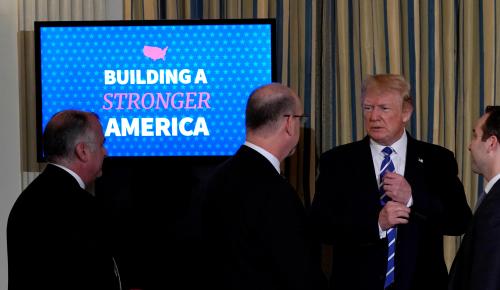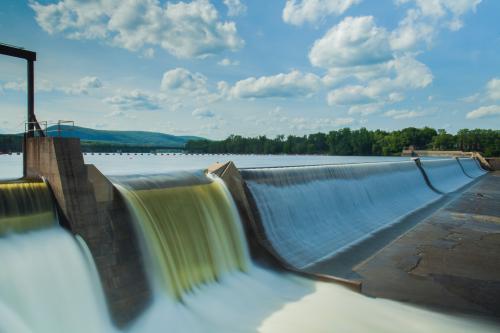Less than two weeks after President Trump’s State of the Union in which he declared that “American heart, American hands, and American grit” would rebuild the country’s infrastructure, workers barely register in his administration’s newly-released infrastructure plan. Out of the plan’s 53 pages, it is not until page 51 that workforce development even gets covered, with little public attention beyond that. Instead, the vast majority of the plan focuses on reforming permits to get projects done more quickly and new programs to boost infrastructure investment.
Given the ongoing need for infrastructure investment nationally, it’s not surprising to see new funding and financing strategies gaining most of the limelight. But relegating workers to the bottom of the plan underplays the enormous opportunity for future infrastructure programs to promote shared prosperity.
In an economic era defined by inequality, infrastructure jobs offer one of the more stable, competitive career pathways to workers across all skill levels. The infrastructure sector employs over 14.5 million workers, most of who fill long-term, good-paying jobs with low barriers to entry. Moreover, there is a huge need to hire and train a new generation of workers in transit agencies, water utilities, and other sectors experiencing a wave of retirement in coming years. Even though a huge boost in construction hiring seems unlikely given the robust labor market at the moment, the presence of infrastructure jobs in every corner of the country makes workforce development an obvious candidate for federal action.
In an economic era defined by inequality, infrastructure jobs offer one of the more stable, competitive career pathways to workers across all skill levels.
And give the Trump administration credit: their proposal recognizes the issue. It encourages more career technical education (CTE), including additional work-based learning and improved job readiness in the skilled trades. Likewise, it proposes more funding for students enrolled in two-year postsecondary education programs, seeing this as a route to help “low-income and low-skilled students” quickly acquire vital skills. The administration’s FY2019 budget also calls for increased funding to apprenticeship programs—$200 million in total—which falls in line with Trump’s executive order to expand on-the-job training opportunities.
However, just as the administration’s proposal paints in broad strokes when discussing several new federal infrastructure investment programs, this rhetoric does too little to capture the workforce opportunities facing the country. Following the administration’s call last spring to support up to 1 million apprentices across all types of infrastructure over the next two years, it is hard to see how the current proposal will come close to achieving this goal.
To start, the proposed interventions are either too small in scale or not specific enough. For example, the proposal not only fails to spell out any specific funding totals for these workforce development efforts as a whole, but also hardly articulates the scope or timeline of any programmatic reforms, including the number of students potentially involved. Similarly, the proposal mentions reforms to licensing requirements in the skilled trades, but has zero to say about what types of licenses would be subject to change. Finally, a call to expand Pell Grant eligibilities for “high-quality, short-term” educational programs means little without specifying the different types of curricula that might be prioritized or the institutions that might receive more federal support, compared to traditional four-year and two-year colleges.
Equally concerning are the proposed budget cuts for other federal job training and educational assistance programs elsewhere in the FY2019 budget. From the Department of Labor to the Department of Education, funded programs could be cut by more than 5 percent. That includes almost $1 billion less combined for Adult Employment and Training Activities and Dislocated Workers Employment and Training Activities. At the same time, many analysts believe changes to existing CTE programs could limit schools’ abilities to flexibly use federal funds. Reduced federal support for student loan forgiveness programs may also make it harder for prospective workers to pursue additional education and seek careers in the public sector, home to many infrastructure jobs.
Admittedly, the administration’s infrastructure plan represents only the start to a broader conversation that has been brewing on Capitol Hill for some time. And if the infrastructure debate goes anywhere in the next few months, Congress is poised to address these workforce issues head-on.
The Trump administration had a chance to lead with a strong, bipartisan message on this front by highlighting workers upfront in its infrastructure plan, but unfortunately, it did not seize the opportunity.
Ideally, Capitol Hill will build on the administration’s concepts and clarify a specific range of infrastructure workforce concerns. In addition to addressing the shortcomings discussed already, new legislation should provide more direct support to local employers and community organizations that are taking the lead on hiring and training new talent. These local efforts often need more financial and programmatic capacity. Improved federal competitive grants and other technical guidance could help, but will require action at the Environmental Protection Agency, U.S. Army Corps of Engineers, and U.S. Department of Transportation. Infrastructure jobs present an enormous economic opportunity—and the overall effort requires coordinated action across the federal bureaucracy.
The Trump administration had a chance to lead with a strong, bipartisan message on this front by highlighting workers upfront in its infrastructure plan, but unfortunately, it did not seize the opportunity. The good news, of course, is that workers at least appear somewhere in the plan, and there is a recognition that additional training and skills development need to be topics in future discussions. Ideally, these issues will gain even greater visibility in the months to come.
Photo credit: Bryan Municipal Utilities







Commentary
Trump’s infrastructure plan puts workers at the bottom. They should be at the top
February 28, 2018